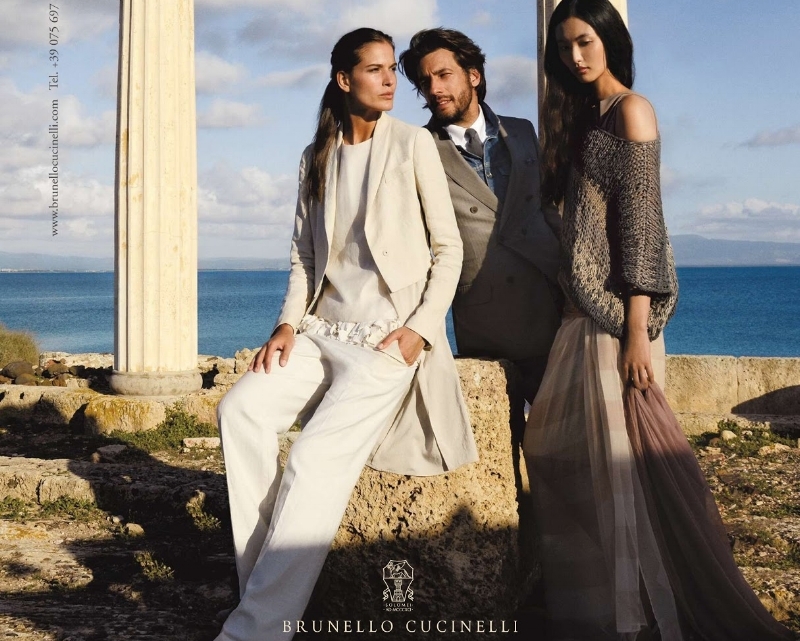
image: Brunello Cucinello
In light of constrained consumer spending in Europe and still softening growth in China, the past several years have seen luxury brands – from Louis Vuitton to Chanel – suffering. Brunello Cucinelli, which is known for its pricey suits and cashmere blends, has not been one of them. Google “Brunello Cucinelli revenue” and a few words and phrases stand out: “Double-digit growth” is one. Revenues “rise,” “jump,” “soar” are others. And sales are “strong,” “growing,” and so on.
And right in line with recent reports (sales for Cucinelli have not been down since 2013, and even this is was very minimal), the Italian luxury goods maker announced last month yet another rise in sales – revenues are up by 10.7 percent to 243.3 million euros ($277.4 million) in the first six months of the year, compared with 219.8 million euros ($250.6) in the same period last year.
“We are particularly pleased with our company’s performance in the first half of 2017; we believe that the results achieved in terms of growth are noteworthy both for their consistency and their compliance with expectations,” Chief Executive and Chairman Brunello Cucinelli said in a statement on Thursday. Cucinelli further noted that the growth is from “all markets and across all channels” and that “considering the excellent quality of sales, we believe that profitability, too, will improve with a similar pattern.”
The rise in revenues was likely also aided by the opening of five new directly-owned shops between 2016 and this year, including its first in the Middle East – in Dubai and a new Milan-based boutique, bringing the count of self-owned and operated stores to 122.
Humanist Capitalism
Founded in 1978, Brunello Cucinelli has been the subject of significant interest in recent years in connection with its ability to continue to growth its brand and demand for its pricey garments (even the brand’s sample sales are out of reach for most consumers). But maybe significant: Its founder’s self-proclaimed “employee-centered approach humanistic capitalism.”
Cucinelli, 62, quite notably headquarters the company in Solomeo in central Italy, a town that he has worked to revive beginning in the late 1980’s. He bought the central part of a medieval castle from its absentee owner and moved the company there in 1987. Cucinelli restored the castle for his living quarters and a school, where young people learn arts, including knitting and masonry. Nearby is a library open to employees. Farther down the hill, artisans weave $3,000 cashmere sweaters from the undercoats of rare Hircus goats.
As Bloomberg noted last year, Cucinelli (pictured below, center) insists on balance at his company. That includes a 90-minute respite at 1 p.m., when workers break en masse for lunch that costs a few euros in the subsidized canteen. On this Monday, they’ll dine on steak, pasta, and local produce bathed in Cucinelli’s own olive oil. His Brunello & Federica Cucinelli Foundation extends the philosophy to funding projects that make the world more livable. “Restoring a church or maybe restoring a hospital,” he offers as examples.

He asks the 1,000-member staff to stop work at 5:30 and not to send business-related e-mails after that to conserve their creative energies. “People need their rest,” Cucinelli says. “If I make you overwork, I have stolen your soul.”
Cucinelli says he is out to make money with his company, which maintains a $1 billion market valuation. Since listing on the Milan stock exchange in 2012, Brunello Cucinelli SpA has recorded impressive growth. In 2014, for instance, sales increased 10.4 percent to $472.8 million, more than double the average of 37 luxury-goods companies compiled by Bloomberg Intelligence.
He insists that the markup for the company’s goods must be reasonable. His company’s operating margin is 13.8 percent, lower than the average of 17 percent for its peers, according to data compiled by Bloomberg. “Would you buy a product if you knew the manufacturer made a huge, preposterous profit?” he asks.
Cucinelli says his prices reflect his garments’ hyperlocal production, handcraftsmanship, and sustainable sourcing from Mongolia and northern India. He pays employees about 20 percent more than the average Italian manufacturing wage. If this ethos draws customers, all the better, he says. And judging by the company’s consistent revenue increases – and especially compared to its competitors’ struggles – it seems to be working.
One of the only other brands to pull of such a feat in troubled economic times is French fashion house Hermes, whose market value is almost 20 times that of Brunello Cucinelli.







